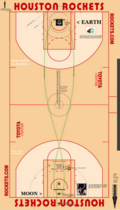English: If the Sun is scaled down to the size of an NBA basketball, 9.45 inches in diameter (24 cm) and placed on an NBA court under one hoop, then the Earth is found under the hoop at the other side of the court. At this scale, the Earth is 2.2 mm in diameter with the Moon orbiting less than 3 inches away (6.624 cm). Mercury is found orbiting the Sun outside of its 3-point line in an elliptical orbit that extends almost out to the half court line. Venus is located on the same side as the Earth, just inside its 3-point line in a much more circular (less eccentric) orbit. If the court is taken to be the ecliptic plane that the Earth orbits around in, then Mercury travels out of that plane to a maximum height of 4 ft 9.77 inches (1.467 m). Venus reaches a maximum height of 3 ft 7.76 inches (1.1116 m). Venus's size is slightly smaller than the Earth, and Mercury's size is slightly larger than the Moon. The Moon's maximum height out of plane is 6.27 mm. A stick of chewing gum is inset to compare how small all of these four celestial bodies are at this scale, where Earth (2.2 mm) being the largest of the four is shown to be half the diameter of a .177 caliber BB pellet (4.496 mm). Other than these four tiny spheres going around the basketball, the vast majority of the region is empty. The planets travel the full circumference all the way around the basketball, not just on the court. And that represents just the slice of space of the ecliptic where such objects are found, let alone the full three-dimensional volume of emptiness. The 2.6 inch (6.624 cm) distance between the Earth and Moon is the farthest that humans have ever ventured beyond the Earth. This court in this image is of the Houston Rockets, chosen in homage to NASA and Houston Control as being the first and only organization to date to send people to the Moon.
The arrow behind Earth's backboard is pointing to the orbits of the other planets, with scale diameters and distances listed. (Distances listed are how far beyond Earth's backboard these orbits are found, not their distances from the Sun). The farthest that human beings have ever traveled is represented by that less-than three-inch distance to the Moon, and this took a three day trip to arrive there. Plans to send astronauts to Mars requires a transfer orbit that reaches Mars when it is at the other side of the Sun, so this would be significantly farther than twice the distance to the Sun plus the minimum distance to Mars, which is more than two court lengths away at this scale. Few people who talk about sending people to Mars fully grasp this fact that the distance alone is 3 orders of magnitude father than the farthest that humans have traveled so far. This Mars trajectory is called a Hohmann transfer, and is a minimization of thrust required to get there (which minimizes fuel, rocket size and therefore cost). A simplistic way to understand why it is preferable to take this min-energy path instead of the shortest line between the Earth and Mars is by analogy to climbing out of a canyon. It takes far less effort to walk up gently rising switchbacks than it would take to attempt to climb straight up and out of the canyon. (Both the canyon climb and the interplanetary trajectory are examples of raising one's energy state in the presence of a gravity well field.)
It is interesting to compare this image where the Sun is scaled to the size of a basketball with the companion image of the Moon scaled to a basketball. Both show the distance to Earth being roughly the hoop-to-hoop full court length. The Sun and Moon, when seen from the Earth, have a similar apparent diameter of basically one-half a degree (with slight variation due to eccentricity of the orbits). Likewise, a basketball when viewed from the opposite end of the court will have an apparent size of roughly one-half a degree. While the Sun is 400 times larger than the Moon, it is also 400 times farther away. This similarity in apparent size is most obvious during a solar eclipse.
A total of five Wikicommons images were combined to create this image, which was made using MS-Paint and GIMP image editing software.






